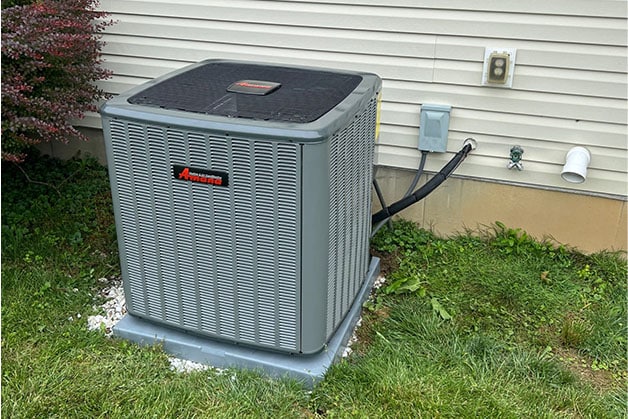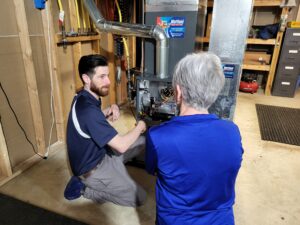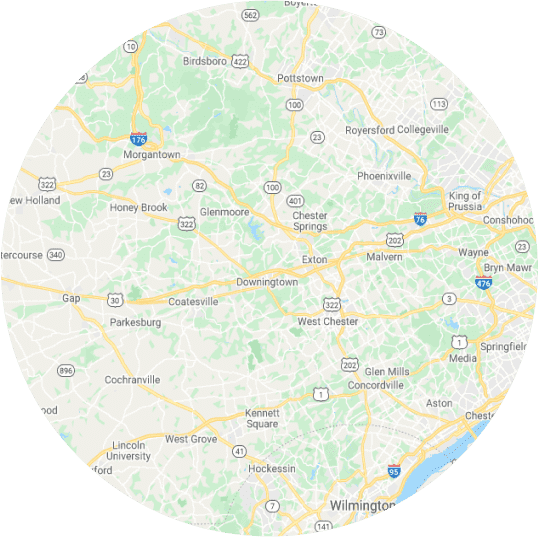How Much Does It Cost to Replace an Air Conditioner in 2024?

Read Time: 8 mins | Last Revised: April 11, 2024
Several variables factor into how much an air conditioner replacement costs. We’ve identified seven of the most important ones that can help you in your AC search.
Your air conditioner is the unsung hero of the dog days of summer, as it works around the clock to keep your home cool and comfortable. Understanding the pricing behind replacing an older AC system is critical in making the best investment for your home’s future.
Your personal home cooling priorities might be anything from performance and efficiency to the upfront cost of the system.
Lining these priorities up with the factors that influence how much the system will cost is an effective way to hone in on an air conditioning system that meets your goals and fits your budget.
We cracked open our price book and put together this article to help you understand how much each of the following seven variables impacts the final costs of the system:
- System Type & Equipment Matching
- Cooling Capacity Needs
- Energy Efficiency of the System
- The Complexity of Installation and Ductwork Modifications Needed
- Accessories & Additional Systems
- Geography
- Quality of the Installation Company
Lining up these pricing factors with your cooling priorities allows you to narrow down your search to a handful of air conditioners that meet your goals and fit your budget.
Let’s kick things off by looking at the broadest system-type categories.
1. System Type & Equipment Matching
Air conditioners have different options when it comes to their capability to throttle temperature outputs. The first and biggest piece of the AC pricing puzzle is whether you’re going with a single-stage, two-stage, or variable-speed system.
- Single-stage units operate at either full capacity or not at all.
- Two-stage units have an added stage at roughly 65% capacity.
- Variable-speed units can run at virtually any capacity.
Performance and energy efficiency typically increase as you go from single-stage to two-stage to variable-speed, so this is a decision that’ll impact your comfort and monthly utility costs.
For a more detailed explanation of the technological differences between these systems, check out our article about the pros and cons of these types of air conditioners.
In the Greater Philadelphia Region, most homes use an air conditioner that functions with an evaporator coil on top of their furnace, which lends its blower motor to the cooling system.
Blower motors control the fan that sends outgoing air to circulate through your home. They’re housed in the furnace and usually mirror that system’s capability of throttling to run at different speeds.
Because of this overlap in components, you’ll have to consider your existing furnace type and the wiring in your home when selecting your AC system. This is where things get a little tricky: equipment matching.
Single-stage air conditioners are compatible with virtually any type of furnace, while two-stage air conditioners require a two-stage or variable-speed furnace. Meanwhile, variable-speed air conditioners are only compatible with variable-speed furnaces.
What if you don’t have a furnace? Then you’ll need to get an air handler in lieu of the evaporator coil. Air handlers add roughly $5,000 – $8,000 to the cost of installation.
If you’re looking at upgrading one of your systems, it’s possible that replacing both your heating and cooling systems at the same time might make sense. If this all seems confusing or overwhelming, don’t worry. Our HVAC professionals are here to answer all of your equipment matching questions.
Here’s a birds-eye view of all the possible price ranges for each different type of system:
- Single-stage AC units typically range between $6,000 and $17,000
- Two-stage AC units typically range between $10,000 and $18,000
- Variable-speed AC units have a significantly wider pricing range due to their need for either an air handler or a matching furnace. Variable-speed air conditioners also have a wide range of efficiency ratings, which means that their average price can be as low as $14,000 or up to $37,000, including the price of an air handler.
Where your total installation cost falls within these price ranges will be determined by our other six variables, mainly by the next two: the cooling capacity and energy efficiency of the system.
2. Cooling Capacity Needs
Cooling capacity is measured in tonnage and refers to the amount of heat that a cooling system can remove from the home, resulting in cooler indoor temperatures.
We sometimes refer to the capacity of an air conditioner as its “size.”
Matching your home with an appropriately sized air conditioning system will help with your home’s comfort and reduce energy costs, while also promoting the health and longevity of your system.
In general, the greater the capacity needed, the higher the cost of the system.
Every home has unique cooling capacity needs based also on the following variables:
- The square footage and insulation rating of your home
- The total number and efficiency of your windows and doors
- The number of people living in your home
- The direction that your home is facing
- The appliances in your home
- The color of your roof and exterior
The size of your existing ductwork also plays a very important role in determining the appropriate cooling capacity for your home.
Ductwork that’s too narrow won’t be able to facilitate the airflow of a larger AC system that might otherwise fit your home.
If your ductwork is too wide it’ll need an oversized AC system to be able to produce adequate airflow, however this will hinder efficiency and the comfortability of your home.
Don’t hesitate to talk with your HVAC professional about your existing ductwork and how it impacts your new system options. Modifications to your ductwork are sometimes the best bet for solving this.
For assistance with determining how much cooling capacity your home needs, it’s best to talk with your HVAC professional.
3. Energy Efficiency of the System (SEER2 Ratings)
If you want to spend less on monthly electrical bills, then you’ll probably want to explore some of the more efficient air conditioners.
Your guide with this is a rating scale from 13 to 26 called the Seasonal Energy Efficiency Ratio, or SEER2.
While the differences between single-stage, two-stage, and variable-speed systems indicate how efficient a system is, the SEER2 rating system tests the equipment under specific conditions to provide a precise efficiency analysis.
It’s worth noting that, although it’s uncommon, we’ve seen some single-stage systems score a higher SEER2 rating than some variable-speed systems.
In most cases, the higher the SEER2 rating, the higher the installation price.
- A low-efficiency AC system scores between a 13 – 14 SEER2 rating.
- An average-efficiency AC system scores between a 14.1 – 17 SEER2 rating.
- A high-efficiency AC system scores between a 17.1 – 26 SEER2 rating.
4. The Complexity of Installation & Ductwork Modifications Needed
While most installations are straightforward, there’s the potential for additional costs tied to the increased complexity of installing your new air conditioner.
Things like additional crew members, materials, modifications, accessibility, and added time are all factors that can increase the price of installation.
While every job is unique, here are some specific situations that may raise the installation costs:
Accessibility of the Installation, Modifications & Additional Materials Needed
Air conditioner installations sometimes require additional or unusual work such as:
- Hanging the outdoor unit on the side of the house if there is no space for it on the ground.
- Cutting holes through drywall or the exterior of your home to run lines or wiring.
- Making additional modifications to create access to span the distance needed for lines or wiring.
- Major duct modifications to physically fit the system or to handle the proper amount of airflow needed.
- Crawl space installations require installers to work while laying down.
Your new air conditioning system may require a new refrigerant line, wiring, or ductwork to be installed properly.
The three factors impacting just how much additional materials will raise the total installation cost are the type of material, the distance that needs to be spanned, and the difficulty of accessing that distance.
- Refrigerant line: The lines connecting your indoor and outdoor AC units could span 75 feet or more.
- Wiring: Wiring may also need to span up to 75 feet or more.
- Ductwork: Modifications to the ductwork closest to your furnace may be needed, and in some cases a plenum or return drop may need to be added for the system to be installed properly.
Making the necessary considerations to provide a quality installation can increase the price, however doing so will make sure that your system is set up for success and longevity.
Attic Installations
If your HVAC system is housed in your attic, some potential factors could impact the logistics of the job:
- Ease of access: Lifting the system up a ladder and fitting it through a narrow opening
- Workability: Walking on joists if there is no flooring can add to the complexity of the job.
- Temperature: Summer attic installations sometimes require additional manpower to allow the installers to rotate working as temperatures in the attic are usually over 125°F and can reach up to 160°F.
5. Accessories & Additional Systems
HVAC accessories like indoor air quality products and smart thermostats can enhance your home’s comfort and the accessibility of your heating and cooling systems. These additional investments add to the total cost of your HVAC installation.
Here are the average costs to install additional products and systems into your home:
Whole-House Dehumidifiers cost between $2,500 and $4,500 to install, depending on the size of your home, the amount of humidity that needs to be removed, and if the system will be ducted in, if it’s stand-alone or zoned for both.
Whole-House Humidifiers cost between $900 and $3,500 to install, depending on the size of your home.
Whole-House Air Scrubbers cost around $1,600 to install. If your home is large enough to call for two AC systems, we recommend getting two air scrubbers.
Whole-House Air Purifiers cost between $600 and $3,000 to install, depending on the type of air purifier and size of the system.
Energy Recovery Ventilation Systems (ERVs), also known as air intake systems, cost between $3,000 and $6,000 to install.
Smart Thermostats are sometimes required for variable-speed furnaces and variable-speed air conditioners. If you don’t have one already that is compatible with your system, they cost between $700 and $1,200 to install.
6. Geography
Like many other goods and services, your geographic location also influences the price of installing a new air conditioning system.
For instance, an air conditioner installation in a large city like New York will be more expensive than in a small town. The socio-economic status of where you live plays a part in this as well, however these price differences aren’t easily measured.
Although this factor is out of our control, staying aware of it will give you a better idea of how much your installation should cost, and if you’re getting a good quote or not.
7. Quality of the Installation Company
Not all HVAC installation companies are created equal. The quality of the company providing your installation services, and how they train their installers, is going to affect the total cost of installing your new air conditioning system.
It’s not uncommon for a less professional company that overlooks the details of a quality installation to offer lower prices.
If you get an appealing quote from a service provider who lacks testimonials or pictures of previous work, it might be a red flag that you’re talking to a corner-cutter installer.
Poor installations often follow cheap prices, which has several negative consequences on your new system’s performance, efficiency, and longevity.
Conversely, an HVAC installation company that provides trained, licensed, and experienced installers will deliver a quality installation that may come at a higher price, but will set your new system up for optimal performance, efficiency and longevity.
Considering how future repair costs and efficiency levels impact the long-term costs tied to your air conditioner helps to put the quality of installation into context.
Making Your Air Conditioner Replacement Decision
As you can see, there are a lot of variables in play that influence the final price of a new air conditioning system, and some of these factors are outside of your control entirely. Suffice it to say, no two installations are identical.
If you haven’t already, here is a sound approach to your air conditioner replacement search.
- Rank your home cooling priorities.
- Compare your priorities to the information covered in this article.
- Speak with an HVAC professional to narrow down your search to a few options.
Following these steps in order will help you start to sift through all the air conditioner options available and narrow down your search to a small list of options suited for your home.
When it comes time to talk with an HVAC professional, be sure to ask all of your questions as understanding your options is the best way to make a sound decision for the future of your home.
Our HVAC professionals are ready to guide you through this important process. To speak with the Mattioni team about air conditioner pricing, call us at 610-400-8510 or schedule an appointment online today.






